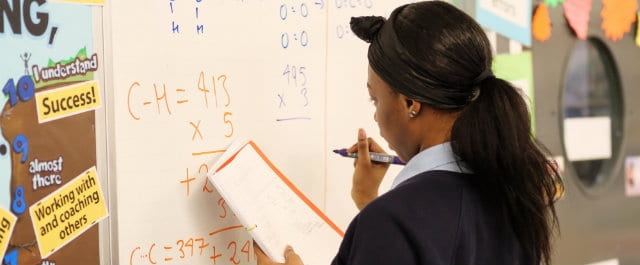What’s behind the headlines? Exploring another round of international league tables
By Blog Editor, IOE Digital, on 8 December 2020
Tina Isaacs, Mary Richardson and Jennie Golding.
Reports from the latest round of international testing – the Trends in International Mathematics and Science Study (TIMSS), published today, will provide much material for study over the coming months and years. Now in its seventh four-yearly cycle, TIMSS tests 10 and 14-year-olds – in England, pupils in years 5 and 9 – in maths and science knowledge and understanding. It also gathers information on pupils’ school and home contexts.
It is this combination of data that could help us understand how to improve teaching and learning for those groups – often disadvantaged – that are doing less well than others.
In 2019, 64 countries and eight benchmarking systems participated, with over 580,000 pupils tested. We co-wrote the report for England (PDF), which was published today.
Overall, England’s pupils did pretty well – eighth out of 58 countries for year 5 maths; 13th out of 39 countries for year 9 maths; 12th out of 58 countries for year 5 science; and 14th out of 39 countries for year 9 science[1]. Sometimes the score differences between countries are not statistically significant, however. What’s important, though, is to try to peer behind those facts, and, we hope, open avenues for further, more in-depth research.
In this cycle England’s year 5 pupils’ performance in maths was significantly above the international average and was the highest of any TIMSS cycle yet – though still well below performance in the highest-attaining, largely east Asian, countries. Most of this improvement came from pupils achieving at the higher end of the TIMSS scale. Year 9 mathematics performance was relatively stable. Relative success in maths is likely to have been underpinned by significant investment in maths teaching from 2014.
Science told a bit of a different story. While year 5 pupils’ scores were on a par with those from 2015, year 9 pupils’ scores dropped significantly and were the worst outcomes of any TIMSS cycle. Worryingly, the percentage of pupils at the lowest end of the scale doubled from 2015, from 5% to 11%. The reasons for this change are not obvious and require additional research – was it because many schools start GCSEs in year 9 now, leading to shifts in the curriculum content taught? Or perhaps the fact that most pupils no longer take SATs in science at the end of key stage 2, leading to a lesser emphasis on science as schools focus on ensuring pupils are prepared for the Year 6 reading, writing and mathematics tests?
Overall, fewer pupils in England reach the advanced and high benchmarks in both maths and science than those in the highest-performing countries. And concerningly, wide achievement gaps remain between England’s most and least advantaged pupils, something that certainly requires a closer look.
Gender differences in scores are not particularly stark, and pupils who are more confident and like maths and science score more highly than those who don’t. But we don’t know whether confidence tends to cause or be caused by higher performance – if either.
What is troubling is that girls remain significantly less confident and on average, liked both maths and science less than boys in both year groups. This pattern is not uniformly found across participating nations but in England it is persistent and arguably results in later under-participation in STEM subjects by girls.
On the whole, mathematics performance was similar across ethnic groups, while in science Black pupils scored below White pupils. Pupils with English as an Additional Language (EAL) scored broadly the same as non-EAL pupils except in year 9 science, where pupils with English as their first language outscored their EAL peers.
Of most concern were the achievement patterns for pupils on free school meals (FSM). They performed significantly below their less disadvantaged peers across both year groups and both subjects.
Another way of gauging socio-economic status is the number of books pupils have at home. Here there was a wide performance gap for both year groups in both subjects, between pupils who have very few books at home and those who have many. The attainment gap between the two groups was around 100 scale points in about 700.
And while teachers said their schools did not have significant discipline problems, a finding largely echoed by the pupils, performance was weaker when pupils did say that they were frequently bullied, or that their classes were often disrupted. These aspects might warrant further exploration.
Overall, the 2019 TIMSS results saw year 5 pupils’ performance in mathematics improving, year 9 mathematics and year 5 science stable, and year 9 performance in science declining, which indicates to us that more granular research around the science outcomes is needed. Further research might also explore why it is that girls’ more limited confidence in, and enjoyment of, mathematics and science is so persistent, given the recent curriculum emphases and other initiatives in STEM subjects. Behavioural, disadvantage, and wellbeing-linked issues might also be subjects for further investigation.
We look forward to beginning these explorations.
[1] If you include the benchmarking education systems, the numbers change slightly: England’s pupils are 9th out of 66 (58 countries and eight benchmarking systems) for grade 4 maths; 17th out of 46 (39 countries and seven benchmarking entities) for grade 9 maths; 14th out of 64 for grade 4 science and 18th out of 46 for grade 9 science.
 Close
Close




